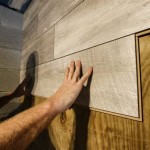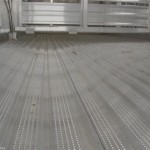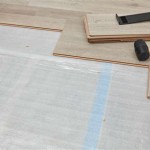Installing Tongue and Groove Flooring on Stairs: A Comprehensive Guide
Installing tongue and groove flooring on stairs can significantly enhance the aesthetic appeal and value of a home. This process, while relatively straightforward, requires careful planning, precise measurements, and meticulous execution. Failing to adhere to proper techniques can result in uneven surfaces, squeaking, and premature wear. This article provides a detailed guide to successfully installing tongue and groove flooring on stairs, covering essential steps from preparation to finishing.
Before commencing the installation, accurately assessing the existing staircase is crucial. This involves identifying the type of stair construction (e.g., open stringer, closed stringer), the condition of the existing stair treads and risers, and any existing flooring materials that need removal. Properly understanding these factors determines the necessary materials and the subsequent installation procedures.
The installation process typically involves removing the existing flooring material, preparing the subfloor, cutting and fitting the tongue and groove flooring, securing the flooring to the subfloor, and applying necessary finishes. Each step demands careful attention to detail and the use of appropriate tools and materials.
Key Point 1: Preparation and Assessment
The initial phase of installing tongue and groove flooring on stairs involves thorough preparation and assessment of the existing staircase. This includes a detailed inspection of the treads, risers, and stringers, along with necessary measurements. The goal is to identify any structural issues or irregularities that need addressing before proceeding with the installation.
Firstly, the existing flooring material on the stairs, such as carpet, vinyl, or old wood, requires removal. This often involves using a utility knife, pry bar, and other appropriate tools to carefully detach the material without damaging the underlying subfloor. Any adhesives or staples left behind must also be removed, as they can interfere with the proper adhesion of the new flooring.
Once the existing flooring is removed, the subfloor, typically made of plywood or OSB (oriented strand board), needs inspection. Any signs of damage, such as cracks, warping, or rot, must be rectified. Small cracks can often be filled with wood filler, while larger areas of damage may require replacing the affected sections of the subfloor. Ensuring a solid and level subfloor is critical for a successful installation.
Accurate measurements of the stair treads and risers are essential for precisely cutting the tongue and groove flooring. Measure the width and depth of each tread and the height of each riser. Note that these measurements may vary slightly from one step to another, particularly in older homes. It is imperative to measure each step individually to avoid errors during the cutting process.
Consider the overhang (also known as the "nosing") of the stair treads. The nosing is the portion of the tread that extends beyond the riser below it. New tongue and groove flooring planks should either match the existing nosing or accommodate a new nosing profile. This decision depends largely on the desired aesthetic and the structural integrity of the existing staircase.
Finally, determine the direction in which the tongue and groove flooring will be installed. Generally, the planks should run perpendicular to the riser, but specific design preferences and the dimensions of the staircase may influence this decision. Careful consideration of the direction is crucial for minimizing waste and achieving a visually appealing result.
Key Point 2: Cutting and Fitting Tongue and Groove Flooring
After the preparation phase, the next crucial step involves accurately cutting and fitting the tongue and groove flooring to the dimensions of the stair treads and risers. Precision in this stage is paramount to ensuring a seamless and professional-looking installation.
Begin by transferring the measurements taken during the assessment phase onto the tongue and groove flooring planks. Use a measuring tape, a square, and a pencil to mark the cutting lines clearly. Double-check all measurements before cutting, as errors at this stage can lead to significant material waste and installation delays.
A miter saw, also known as a chop saw, is the recommended tool for cutting the tongue and groove flooring planks. This saw provides accurate and clean cuts at various angles, which is essential for achieving a professional finish. Ensure that the saw blade is sharp and appropriate for cutting wood; a dull blade can result in splintering and uneven edges.
When cutting the planks, account for the tongue and groove interlocking mechanism. The tongue is the protruding edge of the plank, while the groove is the recessed channel. The tongue of one plank fits into the groove of the adjacent plank, creating a secure and seamless connection. Ensure that the planks are cut in such a way that the tongue and groove align properly when installed.
For stair treads, the flooring planks may need to be cut to accommodate the nosing. This can be achieved by either cutting a custom nosing profile into the plank or by installing a separate nosing piece. If cutting a custom nosing, carefully shape the edge of the plank using a router with a nosing bit or a combination of hand tools. Alternatively, a pre-fabricated nosing piece can be attached to the front edge of the tread after the plank is installed.
Before permanently securing the flooring planks, perform a dry fit. This involves placing the cut planks on the stairs without adhesive or fasteners to check for proper fit and alignment. Make any necessary adjustments at this stage, such as sanding down edges or recutting planks, to ensure a perfect fit.
When fitting the flooring to the risers, ensure that the planks are cut to the exact height and width of the riser. Use a level to ensure that the planks are installed vertically, creating a straight and even surface. Minor adjustments can be made using shims to compensate for any irregularities in the underlying structure.
Key Point 3: Securing the Flooring and Finishing
The final stage of installing tongue and groove flooring on stairs involves securing the cut and fitted planks to the subfloor and applying the necessary finishes. Proper adhesion and a durable finish are crucial for ensuring the longevity and aesthetic appeal of the flooring.
Apply a high-quality wood adhesive to the back of each flooring plank before installing it. The adhesive should be specifically designed for bonding wood to wood and should provide a strong and durable bond. Follow the manufacturer's instructions regarding the amount of adhesive to apply and the curing time.
In addition to adhesive, use finishing nails or staples to further secure the flooring planks to the subfloor. Drive the fasteners at an angle through the tongue of the plank, so they are concealed by the adjacent plank. Ensure that the fasteners are countersunk, meaning they are driven slightly below the surface of the wood, to prevent them from interfering with the future application of finishes.
After the flooring planks are securely installed, fill any nail holes or gaps with wood filler that matches the color of the wood. Allow the wood filler to dry completely and then sand it smooth using fine-grit sandpaper. Remove any dust or debris from the surface before proceeding with the finishing process.
Apply a wood stain to the flooring to enhance its natural color and grain. Choose a stain that complements the overall decor of the home and that provides the desired level of color saturation. Apply the stain evenly using a brush or rag, following the manufacturer's instructions regarding application techniques and drying times.
After the stain has dried completely, apply several coats of a clear polyurethane finish to protect the flooring from wear and tear. Polyurethane provides a durable and water-resistant surface that is easy to clean and maintain. Apply the finish evenly using a brush or roller, allowing each coat to dry completely before applying the next.
Between coats of polyurethane, lightly sand the surface with fine-grit sandpaper to remove any imperfections and create a smooth, even finish. Remove any dust or debris before applying the next coat of finish. The number of coats of polyurethane to apply depends on the desired level of protection and the anticipated traffic on the stairs. Typically, at least three coats are recommended for high-traffic areas.
Finally, install any necessary trim or molding around the edges of the staircase to cover any gaps or imperfections. This trim can be painted or stained to match the flooring and should be securely attached using nails or adhesive.
By carefully following these steps and paying close attention to detail, it is possible to successfully install tongue and groove flooring on stairs and create a beautiful and durable surface that will enhance the value and aesthetic appeal of any home.

Tongue In Groove Flooring On Stairs Shorts

How To Install Laminate Flooring On Staircase Step By Guide

How To Install Laminate Flooring On Stairs Direct Wood

How To Make Stair Treads With Prefinished Flooring And Floormade Nosing Rw Supply Design

How To Install Laminate Flooring On Stairs 13 Steps

Installing Laminate Flooring On Stairs Diy

Stairs Installation Installing Hardwood On Stair Landing Mryoucandoityourself

How To Install Laminate Flooring On Stairs 13 Steps

How To Install Laminate Flooring On Stairs Direct Wood

How To Install Vinyl Plank Flooring On Stairs In 6 Steps Inc
Related Posts








